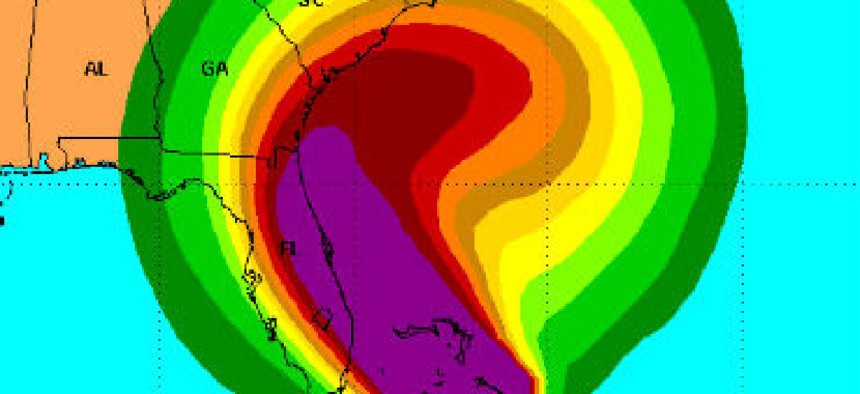USGS expands sensor network to track monster hurricane

The USGS is building out a sensor network in states where Hurricane Matthew is expected to have its biggest impact, to help weather and emergency officials monitor the storm's vital signs in real time.

Detail of wind speed map of Hurricane Matthew. (Image courtesy National Oceanic and Atmospheric Administration.)
The internet of things is tracking Hurricane Matthew. As the monster storm draws a bead on the south Atlantic coast after wreaking havoc in the Caribbean, its impact will be measured by a sensor network deployed by the U.S. Geological Survey.
USGS hurricane response crews are busy installing two kinds of sensors in areas across four states where the agency expects the storm to hit hardest. The information the sensors collect will help with disaster recovery efforts and critical weather forecasts for the National Weather Service and the Federal Emergency Management Agency.
As is the case with most things these days, the storm will be tracked online.
The information collected will be distributed live on the USGS Flood Viewer to help federal and state officials gauge the extent and the storm's damage as it passes through each area.
FEMA, which tasked USGS with the sensor distribution, is also talking with other federal and state officials further up the Atlantic coastline about whether the equipment is needed there. Recent forecasts call for Matthew to take a sharp easterly turn and head out to sea as it reaches the North Carolina coast.
USGS crews are in installing storm-surge sensors at key sites along the coasts of North Carolina, South Carolina, Georgia, and Florida in anticipation of the storm, said Brian McCallum, associate director for data at the USGS South Atlantic Water Science Center.
In all, USGS is deploying more than 300 additional weather and condition sensors, he told FCW in an interview on Oct. 5.
The devices come in two varieties. The first are 280 storm surge sensors, set out in protective steel tubes lashed to piers, bridges and other solid structures in the storm's projected path. The low-cost devices will provide the highest density of storm data, such as depth and duration of the storm surge, McCallum said. The devices won't communicate their information in real time, however; McCallum said USGS crews will come in behind the storm to upload the sensor data to the Internet.
The second set of sensors, however, could be thought of as the storm's "live tweets." USGS is installing 25 rapid-deployment gauges to augment its existing collection of sensors and fill in gaps along the coast. The additional gauges will be installed in areas that might not be accessible during the storm because of flooding, according to McCallum. USGS, he said, will deploy three of the sensors in Florida, and an additional 22 in Georgia and North Carolina.
The data collected by the rapid deployment gauges, which sense wind speeds and direction and other data to help with forecasts and flood conditions, will be sent out live during the storm, McCallum said.
NEXT STORY: Why Google Is Building Its Own Phones Now





